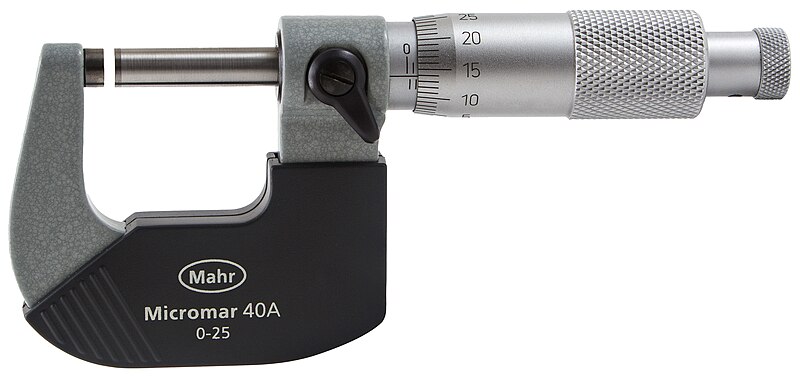On the subject of weird measurements, I worked in the hard disk drive industry throughout the 90s. A very commonly used unit was microinches. Also microns (µ) which is one millionth of a meter. I never heard micrometer.
1 microinch = .0254 µ.
On the subject of weird measurements, I worked in the hard disk drive industry throughout the 90s. A very commonly used unit was microinches. Also microns (µ) which is one millionth of a meter. I never heard micrometer.
1 microinch = .0254 µ.
FWIW, here in the metric country of Germany, every engineer, mechanic or other tech person will talk about µs (“Müs”) when meaning micrometers. In colloquial speech, one µ is equivalent to a “Mückenbein”, a “mosquito’s leg”.
A micrometer is also a tool that looks like this:

However, I know for a fact this unit is commonly used, e.g. in this random figure:
https://www.researchgate.net/publication/342762375/figure/fig3/AS:910842199560192@1594173111039/Overview-of-superhydrophobic-plants-found-in-nature-displaying-unique-hierarchical.png
It’s colloquially called “Mikrometerschraube”, “micrometer screw”, in German.
Did they use “inch” or “pouce”, the actual word that was used here in Quebec before Canada went metric?
In Canada we use metric for nearly everything. Not for TV screen size, but for distance and milk and beer. But I think that a sheet of plywood is still 4’ x 8’. And a friend of mine spent a sabbatical in Oslo and wanted a length of 2 x 4 (which is, of course, something like 1.5 x 3.5 inches) and went to lumber yard and asked for a 5 x 10. He was astonished to hear the clerk call into the cutting room for a lenght of 2 x 4.
And my car mechanic grumbles about needing two sets of wrenches.
Just as well in English you can call it a micrometric/micrometer screw, screw micrometer, micrometer screw gauge, and so on; I don’t think there is any difference.
What is (maybe) relevant is, if I am correctly reading my dictionary, the instrument is called a micrometer but micrometre can only mean a millionth of a metre.
This is only a wild guess, but I figure in actual use the abbreviation μm will be found to be much more common; why spell out “micrometre” everywhere? In speech I can imagine people talking about “microns”: quicker to pronounce.
Mediamarkt Belgium’s site is full of ads for things like LG 55UR78006LK 55" FULL LED Smart 4K… Taille de l’écran (cm/pouce): 140 cm / 55 pouces
The tool is a mi-CROM-eter. The unit would be a MI-cro-meter but, as mentioned, we call it a micron.
This. Spelled the same. Not pronounced the same.
A funny thing is that there’s no friggin’ way to use a micrometer (tool) to measure to micrometer (unit)- level accuracies.
The name of the tool dates from the days when a fraction of a millimeter or a thousandth of an inch was high precision. IOW Ye Olde Darke Agyes of machining.
Which brings up a another couple of units of measure that old machinists would use when I first started my career.
A thou is a thousandth of an inch.
A tenth is a tenth of a thou or a ten thousandth of an inch.
There’s also another style of tool called a micrometer, with sliding calipers. Usually they have a Vernier readout, but mine has a dial, and nowadays a bunch of them are digital. They’re nice in that they can measure all three of outer dimension, inner dimension, and depth.
Also known as a mil, used a lot in circuit boards (pads and wiring).
What on Earth do you mean?

Each unit there is one micrometer, i.e. that is the precision of the measurement. (Current reading is a hair below 5.783 mm)
And garbage bag descriptions.
Yes, and yes for Canada. We’ve gone fully metric but it’s hard to shake the US influence. TV screen sizes have always been expressed as diagonal inches and still are. Just like how oven temperatures for most (not all) recipes are in degrees Fahrenheit, but not weather forecasts.
Earlier today I would not have guessed that my nught would include watching an 11 and a half minute video on how to read a micrometer.
Or my night, either.
Me neither. I love a good cat video as much as the next person, but I’m totally going to watch that video when get home.
The problem with lumber sizes is well known. (actual dimensions are often substantially different from the nominal size.)
Woodworking machinery lasts a long time and much of it is calibrated in imperial. Some dimensions translate readily - 4’ x 8’ becomes 2400x1200mm. 2" x 4" becomes 50 x 100mm. Near enough for jazz as they say.
We have this weird system in Australia where timber matches its dimensional description. I know, I know. We are a bit odd. Not sure how we manage to work through the confusion, frankly.